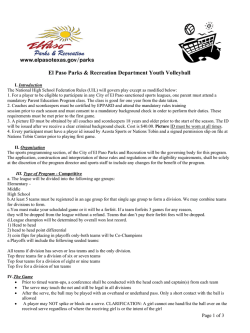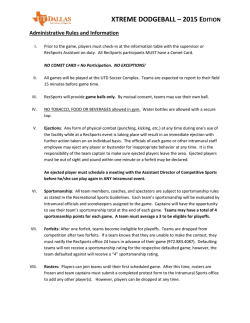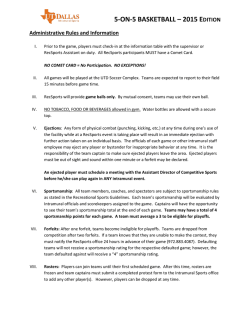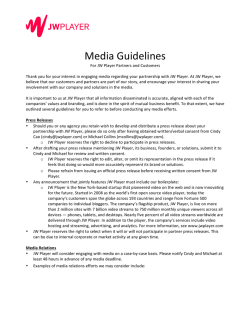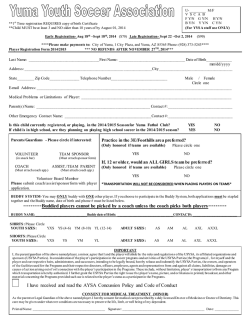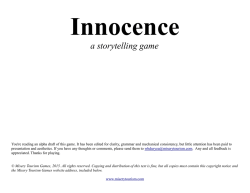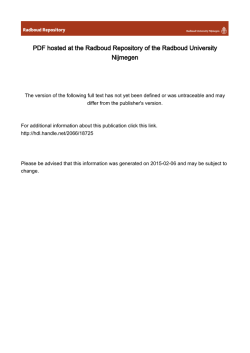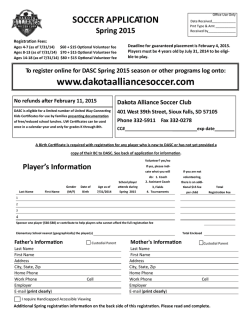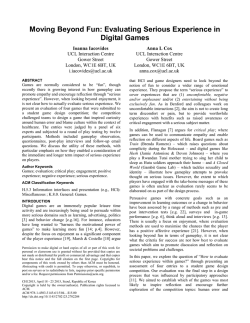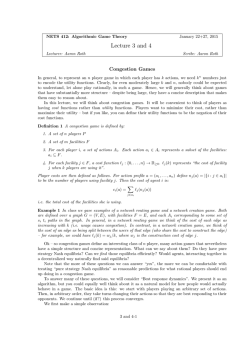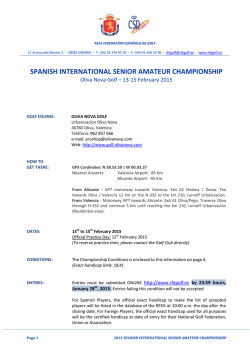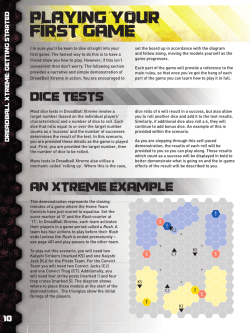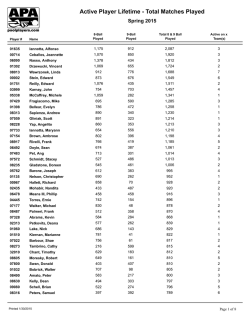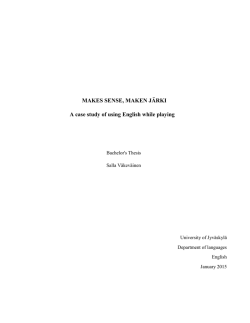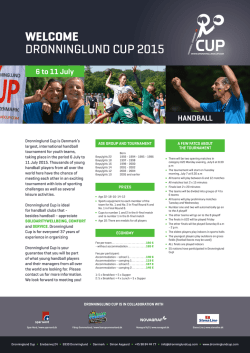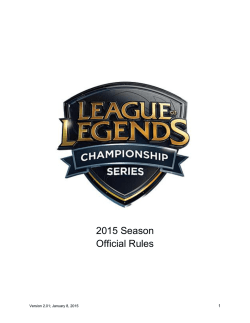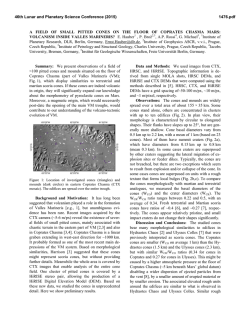
7+yrs - OSCN
for 7+ yrs Active Games OSCN’s little book of Spud © The Out of School Care Network (2014) For more games ideas visit our website www.oscn.org.nz Depending on size of the group, pick 1,2,3 taggers, give each a ball. Tag by rolling the ball. Only hits below the knees are a legal tag. If tagged, sit down. Try to touch a ball as it comes past to get free. Poison Ball Divide group into pairs. Each pair stands side by side with arms linked facing opposite directions. Select one pair to start. One is the tagger and the other is the runner. Tagger chases the runner, if the runner is tagged, they switch roles. The runner at any time can escape by linking arms with a pair (facing the opposite way). Then the player on the other end is “bumped” off and is the new runner. Bump (Elbow Tag) Capture the Flag Teams raid to take flags from their opponents and avoid being tagged. Need: large area, flags (bean bags, balls...), cones. Mark out an area about the size of a soccer field with a centre line. Divide the players into two teams. Each team lines up behind their end lines. Each team has a number of “flags” (whatever) placed along their end line, roughly the same number of flags as team members. (Each team has same number of flags, all same colour, different from other team.) Simple idea: grab something and get home, without getting tagged. How will you do it? Two teams line up facing each other, about 10m apart. Mark each team’s line clearly. Arrange team members by height, shortest to tallest. Each team numbers the same way (either tallest to shortest or vice versa.) The “bacon” is any smallish “grab-able” object. Place it is placed midway between the teams. The leader calls a number. Players with that number should run to the centre. Either player can take the “bacon” & try to run back to their place in line before being tagged by the other player. If the runner gets there without being tagged, give two points to that team. If tagged, a point is scored for the other team. If a player touches the bacon without picking it up, a point is scored for the other team. Play to a certain number of points. If there is a stand off, call another number and current players return to their places. Leader calls out actions. Do the right action as quickly as possible. Eliminate slowest racers or “send them to the brig” - must be completely silent for one-minute, before returning to the game. Gradually speed up the calls. Add new calls before the previous activity is done. Calls (add your own..) Bow – all run to the bow (front) Stern – all run to the stern (back) Starboard / Port – all run to the correct side Torpedoes – all lie face down on the ground, legs together & arms at sides Into the Lifeboats – sit cross legged, arms folded across chest Row Boats in – (leader calls a number) players line up in groups of that number Captains Coming – stand to attention & salute Scrub the Deck – on hands & knees, scrubbing Shark Attack! – run to boundaries & get off the ground (benches/hoops etc.) More Tag Games On “go”, each team raids to get the other team’s flags. Any players tagged in the opposing team’s half are considered captured and must stand behind the enemy flags. Players may rescue captured teammates by tagging them. They can’t free a player & capture a flag in the same raid. A player who succeeds in grabbing a flag or making a rescue can’t be tagged and may return safely to their half. Captured flags go behind the end line and can’t be taken back. The first team to capture all the other team’s flags is the winner, or end after a set time. Snatch the Bacon An easy ball tag that needs a bit of space. Try with a tennis ball to start with. Number off the players. All players start close together (set up a starting circle. Everyone must have one foot inside the circle.) The first player throws the ball upwards in the air & calls a number. This numbered player is “catcher” and runs for the ball, the others run away (have a set boundary). When the catcher has the ball in hand, they yell “freeze!” & everyone must stop and remain still. The catcher is allowed 3 big steps and then throws the ball to try and tag a player. Players can dodge but they are not allowed to move their feet. If a player is hit they are assigned the letter S and will start off the next round (throwing the ball from the starting place) . If it’s a miss the catcher is assigned the ‘S’ and they start the next round. If a player gets a second letter it’s P, then U, then D. When a player has four letters, that spells SPUD and the game is over. “Spud” has to complete a “forfeit” e.g. sing something, then start another game. (Did you know - Spud used to also be called “Baby in the Air”) Add other actions as everyone gets used to game. Captain’s Coming Tag Games Ostrich Tag A player is safe if they hold their nose with their right hand, with their right arm under their leg. Monkey, Rock, Stick When they tag someone ‘it’ assigns them the role of either: monkey, rock or stick. If a “Monkey” the player must act like a monkey, and can be freed by another player touching them. “Rocks” have to crouch down with their heads tucked low, they are freed when another player jumps over them. “Sticks” must stand with their legs apart & can be freed when another player crawls through their legs. Line Tag (Pacman) Played on a netball/basketball court. Players must stay on the lines. You can have more than one tagger. Have a few ball tees spaced about to “level up” players. All players must walk, but when Pacmen get to a tee they can run for 10 seconds. When the Ghosts (the chasers) get to a tee they can run straight to any other tee and start back on the lines there. Cowboys and Indians A high energy circle tag game - tag the player in front… and keep away from the player behind! Starting off, all players are “Indians” and spread out to form a very large circle. Leave a 2m gap & all face the same way. Cones can be used to make the outline clear. At the leader’s shout or whistle all Indians run around the circle. Each Indian tries to tag the player ahead of him/her before being tagged by the player behind, before the leader signals to stop. Players tagged become “Cowboys” & must sit in the centre of the circle. After the leader calls stop, players regroup, before the leader re-starts. You can play until most of the players are sitting out, or call a “Pow Wow”. Then all Indians go out (they probably need a rest by now) and all cowboys come in. Re-start and tagged players join the Indians group. Swap back, giving the Cowboys a rest by calling “campfire”. You can also add signals to change direction, or suggest hopping, sideways running, skipping etc. Game Tips - Getting Ready Explaining the game. Do less “telling”, more “showing”. Put players in position as soon as possible so they can see what you are talking about and it will show you if you need more/less space. Hold off questions before you have tried it out have a short “test run”, then take questions. Dividing teams - form 2 even teams by asking everyone to get a partner, then each pair splits. Team size - if you have less space, have smaller teams and rotate teams in and out. Numbering off. Can’t remember your number? Get players to call the numbers themselves. Have a pen handy, they can write on their hand if needed. Identifying teams. If you haven’t got bibs. Try home made wristbands, or a bit of face paint, or boys vs girls… Be flexible. Try the rules as written, or play it your way. If it’s not working or getting boring, change it up. Ask your players for ideas. Look for more games here … and on-line at www.oscn.org.nz/games More Tips - Keeping It Going Eliminating players / Ending Games. If you have a game where players go “out”, think about how long they are sitting out for. Other options, depending on how often people go out: re-start the game after a certain number are out. Or swap all the out players with those still in (which gives the in players a rest.) Don’t let it drag - if only a few players are left, call the end. Show how to play. Your participation can help encourage others to join in. Set a good example by toning down your own competitiveness. Step back and look at the big picture. Also take time to step back and see the whole group. Get feedback. Talk to players, watch their reactions and involvement. Don’t let the activity get derailed by one player. Quickly re-direct argumentative or reluctant players. Is there another colleagues you can call on for help? Work closely with other staff so you can keep on track for everyone that want to get on with the game. Learn more about the OSCAR role at www.oscn.org.nz Four Corners Out guess and out run in this high energy game. Mark four corners of a square with cones. One player starts on each corner. A fifth is in the centre. Players on the cones try to change places. The player in the centre tries to get to a cone before another player does. The player left out restarts from the centre. Scale the game for number of players - more cones, more chasers, more space etc. Stretch Race Pair everyone up roughly by size, then separate each pair to form 2 same-sized teams. (One person in one team, one in the other.) Pick an anchor for each team . They begin with one foot on the same starting line, then stretch out. One member from each team then joins onto their team, touching some part of the last player’s body. Keep going like this. After last person joins, who has the longest line? Fun Challenges Popcorn Maker You need a box of 20-30 paper balls or similar low impact objects to throw. One player tries to empty the box of “popcorn” one ball at a time. Everyone else is collecting and returning the popcorn to the box. Adjust the type/amount of balls to get the challenge about right. Try 2 popcorn makers. Rule: popcorn makers cannot block the returning balls. Have a big enough container to prevent accidental blocking or collisions. Variation: have a signal for all player to change to “slow mo”. Don’t Touch! Start in a circle. Place an object like a chair or box in the middle. The task is for everyone to swap places and touch the object on their way to their new spot - without touching any other players. Time each attempt and then try to beat that time. Any touching or collisions, restart. Back to Back Work in pairs of roughly equal height/weight. Sit on ground back to back. On signal, stand up together. Join with another pair and repeat in fours, then eights etc. Circle Games Over Here! Sort the group into pairs. Have a chair or cone for each pair, laid out in a circle. One player in the pair sits in a chair (or on ground - use a cone to mark each spot.) The other player is standing (or kneeling if using cones). Have one player standing/ kneeling on their own - they are the start player. No one wants an empty chair/cone. The lone player gets someone to fill their spot by winking at a sitting player. The sitting player’s partner can prevent them moving by tagging them (if they detect the wink). It they lose their partner, a player can try to wink someone else over. Keep it moving fast and get partners swap roles every few minutes. 360 Degree Bowling Players stand in a circle, legs apart fairly wide, touching the feet of their neighbours. One player is in the centre with a supply of largish balls. Set a time limit for the centre player to shoot balls through the circle of legs - players can only defend with arms. (Wider legs make it easier to reach down to defend.) Rotate players, add a 2nd in the centre and/or limit defenders to 1 arm etc. if too hard. More In Circles These have Less running & movement, good for resting or winding down. Copy Cat A simple filler with not much point. Play sitting or standing in a circle, but maybe try sitting first. Each player picks another player to secretly copy every move that player makes, no matter how small, but the copy should make the movement a bit larger—exaggerate it a little. Keep it going and see what happens - does everyone end up doing the same thing? Ying Yang Yoo A word/action challenge - each word (always said in the same order) has a set action: Ying = hand on top of head, pointing either left or right. Yang = hand under chin, pointing either left or right. Yoo = point to anyone in the circle. Everyone is in a circle. The start player says “Ying” (with action.) The player pointed to must follow with “Yang” (and action). 3rd player (pointed to by 2nd) must say “Yoo”. Whoever the 3rd player points to says “Ying” and continues on. Wizard’s Duel wizards from opposing teams run to a “paper scissors rock” duel. Each team tries to advance further towards the other. good for indoor action. Set up a winding track of cones or other markers. More winding makes for more running. Divide into 2 teams. Teams line up at opposite ends of the track. On ‘go’, the first Wizards run along the track touching each marker as they go. When the Wizards meet, they play “paper scissors rock”. The loser returns to the back of their line. The winner keeps running along the track. As soon as the duel ends, the next Wizard from the losing team starts along the track. When they meet the other Wizard, duel again. Play until one team wins a last duel at the front of opposing team’s line, or until everyone is worn out! Secret Agent A race between teams to find the hidden gems. Divide into 3 teams (each team needs a different coloured tag. One team is the “Border Patrol” (BP). The other 2 teams are “Secret Agents” (SAs). Each team chooses 2 members to each start with a hidden gem (a small object that must always be held in a hand.) At any time, the gems can be passed secretly to other SAs. [A dropped gem is an automatic “find”.] Set a boundary to limit the movement of the SAs. Teams start separated. On “go”, the border patrol all close their eyes and count to 10, then they move out to find the hidden gems. BP members must work in pairs (or 3’s) - if they tag a SA, that SA must show both hands. After tagging, BP must close eyes and count to 10. Set a time limit for each round (try 90 seconds). If both a team’s gems are found they are “bust” and sit out the rest of the round. BP’s score points for each gem they find. SAs score a point if their team is not “busted”. If both teams bust, then 2nd team busted scores a point. Play 2-3 rounds then rotate a new team to be BP.
© Copyright 2026
